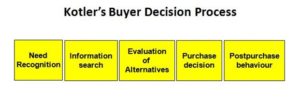Marketing is a critical ally in your effort to build an improved customer experience. They regularly communicate with your customers. If you don’t effectively engage marketing, you’re fighting an uphill battle. They also tend to have influence in the C-Suite, making it even more critical. This may explain why many CX organizations report through marketing.
But even when you are part of marketing, there’s a tendency for a division, especially if marketing is focused on new sales while you’re trying to drive loyalty.
To truly understand how marketing thinks about the customer journey, learn about the buying model they use to organize their efforts. This should tell you a lot.
Marketers use buying models to map customer interactions and to target marketing content. The model shows the stages a customer goes through on the way from a trigger event to awareness to purchase and (hopefully) ongoing loyalty. There’s no standard. We’ve run across many variations, some very detailed, others very general.
This came to mind at a recent Hypothesis Mapping Workshop with a new client. I overheard participants talking about their customer stages. Recognizing their buying model enabled us to have a productive conversation about how they engage customers today, and how we can test this in the journey mapping. Not only will this help us to verify their go-to-market approach, it will also make it easier to communicate results, since we can use their existing customer frameworks.
Although there is no standard buying model, there are some popular ones to review to see their implications.
I’m generally a big fan of Hubspot. They have very good content tools, and their thought leadership is great. I teach Buyer Behavior at the Carlson School of Management, and I use their persona development process in the classroom. Unfortunately, their buying model is too simplistic:
Anybody who loves customer experience (CX) should immediately see a problem. The model completely ignores the post-purchase experience! No service, no word of mouth, nothing.
Contrast that to the Model of Consumer Behavior by Philip Kotler.

The Hubspot model begins with the customer already in the search for a new solution. Kotler’s model starts with the trigger – here called Need Recognition – that starts the process.
What’s more important to CX is the inclusion of a post-purchase phase that’s missing in the Hubspot model. This matters because the buying model is the framework that marketers use to create and distribute content. If they use the Hubspot model, they’re unlikely to focus on what often matters most – the ability to engage with your product or service after the purchase.
While the Kotler model is good, it has one limitation shared by most buying models (and, for that matter, journey maps) – its linear nature. This straightforward march to purchase makes analysis easier – most analytical tools do best with a grid-like approach like this. Excel doesn’t do well with circles, and neither do many more-advanced analytic tools.
While this might be easier to put into an analysis tool, the linear view diminishes the importance of the loyalty loop. We know from Temkin Group’s ROI of Customer Experience that the loyalty loop is important. An average brand can see as 12+% growth in retained sales if they can improve their CX scores by 10%. Yet the visual above doesn’t make that intuitive. And visuals matter.
That’s one reason why I really like the McKinsey Buying Model:

While it’s designed for consumer purchases, it can certainly apply to business purchases, as well. Like Kotler, it begins with a Trigger, leading to the initial consideration set. And their research shows that companies in this initial consideration set are three times as likely to be selected for purchase. Once the initial consideration set is created, the buyer goes through active evaluation before coming to the moment of purchase.
So far, it’s very similar to Kotler, except it combines the Information Search with the Evaluation of Alternatives. The critical difference comes postpurchase. Not only do they include the postpurchase phase, which Hubspot doesn’t – they visually show how an effective postpurchase experience leads to increased sales, since it can cause customers to bypass the entire evaluation process for their next purchase.
Few CX pros I’ve spoken with are really comfortable discussing buying models. But it’s important to do if you want to engage your marketing teams, since they’re actively using them in content marketing discussions. Take the time to learn what buying model your teams use. Then see how you can use this to engage them in a discussion about the post-purchase process.
It’s a great way to start a dialog on value of customer experience.




Thank you, Jim for the insightful article. I have one thing to say that hubspot is considering post sales in Inbound Methodology. There are 4 stage of Inbound Methodology, attract, convert, close and delight. The delight stage is referred to post sales.